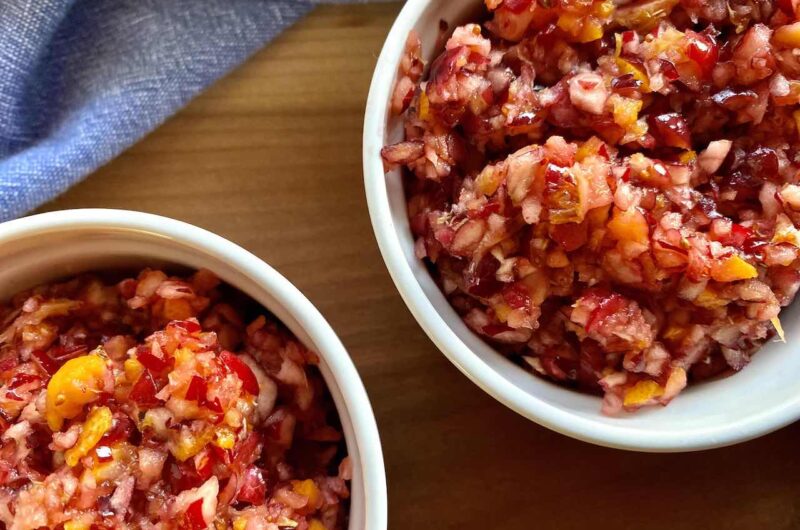
A Bog Blog: Simple Cranberry Relish
As everyone who has eaten a Thanksgiving meal knows, the meal is traditionally full of a lot of orange and brown foods – mashed potatoes, sweet potatoes, bread, stuffing, turkey. Don’t get me wrong, these foods are delicious, but you need the acidity and tartness of cranberry sauce – not to mention the bright red color – to balance out the other foods and make them really sing. Thanksgiving without cranberry sauce is like…well, it’s like Thanksgiving without stuffing or gravy or sweet potatoes or pie. Simply unimaginable.
Over the years I have tried many a cranberry sauce. I’ve experimented with ones where you cook down the cranberries to a gelatinous consistency, or where you add orange juice to make it sweet, or walnuts to make it crunchy. But nothing beats this most simple recipe. To even call this a recipe is, in some way, to cheat – it’s really a five-minute-throw-everything-in-the-food-processor-and-combine activity. Moreover, this is (I’m almost ashamed to admit) the recipe on the back of the Oceanspray bag of cranberries, albeit with much less sugar.
Unsurprisingly, this post is about cranberries, which are native to North America. Long before Europeans arrived on the continent, Native Americans were picking and eating cranberries from Cape Cod and New Jersey all the way to Oregon and Washington. Native Americans had many uses for cranberries, including using them medicinally, to dye textiles, and for cooking. They also used cranberries to make pemmican, essentially a natural power bar made of ground cranberries, ground dried deer meat, and fat tallow that was essential for those traveling long distances in the fur trade.
While early settlers in North America embraced the cranberry – a 1796 cookbook already suggested eating cranberry sauce with turkey – some scorned the culinary tradition. A nineteenth century Bostonian satirist mocked that cranberries were “eaten with almost every species of roasted meat, particularly the white meats, turkies, &c. Some even eat it with boiled fish, and I knew one person, otherwise a very worthy man, who eats it with lobsters, for supper!” Similarly, a French representative to the US was appalled by cranberries, describing them as “the most villainous of American sauces” and explaining his distaste for “the voracious manner in which [Americans] eat it.”
Despite the naysayers, cranberry sauce became a staple on the Thanksgiving table. Cranberries began to be cultivated in the early nineteenth century on Cape Cod, after which cultivation expanded to Maine, then New Jersey by the 1830s, and Wisconsin by the 1850s. In 1912, the first canned cranberry sauce was produced – that jiggly thing that people apparently eat. By 1940, the canned version had become widespread and part of the American Thanksgiving tradition. (Canned cranberry sauce was actually a solution to a faster and easier way that developed to harvest cranberries, known as wet harvesting, which damages berries as they’re picked – see below.) Today, Wisconsin is the largest cranberry producer, growing over half of the cranberries in the US – which is, unsurprisingly, the largest producer of cranberries (followed by Canada and Chile).
But how are cranberries produced? Cranberries grow in bogs, marshes and wetlands that have been drained. Cranberries can be harvested in two ways: through wet harvesting or dry harvesting. In wet harvesting, which is used to harvest 85 percent of cranberries, the whole bog is flooded and then the berries are dislodged from the vines so they float in the water. The berries are then “corralled” and transferred out of the bog. In dry harvesting, a mechanical rake is used to “dislodge” the berries from the vine and are then transferred for sale. While wet harvesting is much easier, faster, and requires less labor, it can also damage berries, making those berries more appropriate to become Craisins, juice – or canned cranberry sauce. In contrast, dry harvesting is used to produce fresh cranberries.
Happy Thanksgiving! Enjoy your cranberry sauce with turkey (or let’s be honest, feel free to substitute chicken, the better poultry), many varieties of potatoes, green beans, stuffing, and more!
Simple Cranberry Relish
Course: Recipe, Side4
servings10
minutesIngredients
1 unpeeled (organic) orange, cut into eighths
1 12-ounce package of fresh cranberries
1/4-1/2 cup of sugar
Directions
- Wash and sort out any sad looking cranberries.
- Add the cranberries and the orange to a food processor and pulse for a few seconds at a time until the cranberries and orange have been chopped into small pieces (but before they become liquid).
- Add the cranberry and orange mixture to a bowl and add the sugar. First add about ¼ cup of sugar, and then taste and add a tablespoon or two at a time until you reach your desired sweetness. You don’t want the cranberry sauce to be too sweet – just sweet enough to hide the bitterness of the cranberries.
- Cover and chill in the fridge for at least an hour. Serve cold.






2 Comments
Alice Stevens
Hi Allie,
This looks great. I am wondering about adding orange zest to the reciepe. I will try it and let you know.
Happy Thanksgiving
Bites & Rights
Thanks, Alice! I usually just add the entire orange, but it probably would also work with orange zest and a peeled orange. Let me know!